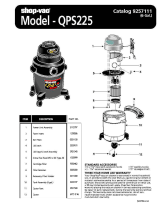
PAGE 2
Never operate this unit when
flammable materials or vapors
are present because electrical
devices produce arcs or
sparks that can cause a fire or
explosion.
NEVER OPERATE
UNATTENDED!
IMPORTANT SAFETY
INSTRUCTIONS
Read all safety rules carefully before attempting
to operate. Retain for future reference.
ALWAYS DISCONNECT THE
PLUG FROM THE WALL OUTLET
BEFORE REMOVING THE TANK
COVER.
ALWAYS WEAR EYE
PROTECTION TO PREVENT
ROCKS OR DEBRIS
FROM BEING BLOWN OR
RICOCHETING INTO THE EYES OR FACE WHICH
CAN RESULT IN SERIOUS INJURY.
When using an electrical appliance, basic precautions
should always be followed, including the following:
READ ALL INSTRUCTIONS BEFORE USING THIS
APPLIANCE.
TO REDUCE THE RISK OF FIRE,
ELECTRIC SHOCK OR INJURY:
1. Do not leave appliance when plugged in. Unplug
from outlet when not in use and before servicing.
Connect to a properly grounded outlet only. See
Grounding Instructions.
2. Do not expose to rain – store indoors.
3. Do not allow to be used as a toy. Close attention is
necessary when used by or near children.
4. Use only as described in this manual. Use only
Manufacturer’s recommended attachments.
5. Do not use with damaged cord or plug. If appliance
is not working as it should, has been dropped,
damaged, left outdoors or dropped into water,
contact Shop-Vac Corporation for assistance.
6. Do Not: pull or carry by cord, use cord as a handle,
ATTENTION!
DANGER!
WARNING!
WARNING!
WARNING!
close a door on cord or pull cord around sharp edges
or corners. Do not run appliance over cord.
Keep cord away from heated surfaces.
7. Do not unplug by pulling on cord. To unplug, grasp
the plug; not the cord.
8. Do not handle plug or appliance with wet hands.
9. Do not put any object into openings. Do not use with
any openings blocked; keep free of dust, lint, hair
and anything that may reduce air flow.
10. Keep hair, loose clothing, fingers and all parts of
body away from openings and moving parts.
11. Do not pick up anything that is burning or smoking,
such as cigarettes, matches or hot ashes.
12. Do not use without dust bag and/or filters in place.
13. Turn off all controls before unplugging.
14. Use extra care when cleaning on stairs.
15. Do not use to pick up flammable or combustible
liquids such as gasoline or use in areas where they
may be present.
16. Do not use your cleaner as a sprayer of flammable
liquids such as oil base paints, lacquers, household
cleaners, etc.
17. Do not vacuum toxic, carcinogenic, combustible
or other hazardous materials such as asbestos,
arsenic, barium, beryllium, lead, pesticides or other
health endangering materials. Specially designed
units are available for these purposes.
18. Do not pick up soot, cement, plaster or drywall dust
without cartridge filter and collection filter bag in
place. These are very fine particles that may pass
through the foam and affect the performance of the
motor or be exhausted back into the air. Additional
collection filter bags are available.
19. Do not leave the cord lying on the floor once you
have finished the cleaning job. It can become a
tripping hazard.
20. Use special care when emptying heavily loaded
tanks.
21. To avoid spontaneous combustion, empty tank after
each use.
22. The operation of a utility vac can result in foreign
objects being blown into eyes, which can result in
eye damage. Always wear safety goggles when
operating vacuum.
23. STAY ALERT. Watch what you are doing and use
common sense. Do not use vacuum cleaner when
you are tired, distracted or under the influence of
drugs, alcohol or medication causing diminished
control.
24. WARNING! Do NOT use this vacuum cleaner to
vacuum lead paint debris because this may
disperse fine lead particles into the air. This
vacuum cleaner is not intended for use under EPA
Regulation 40 CFR Part 745 for lead paint material
cleanup.

























